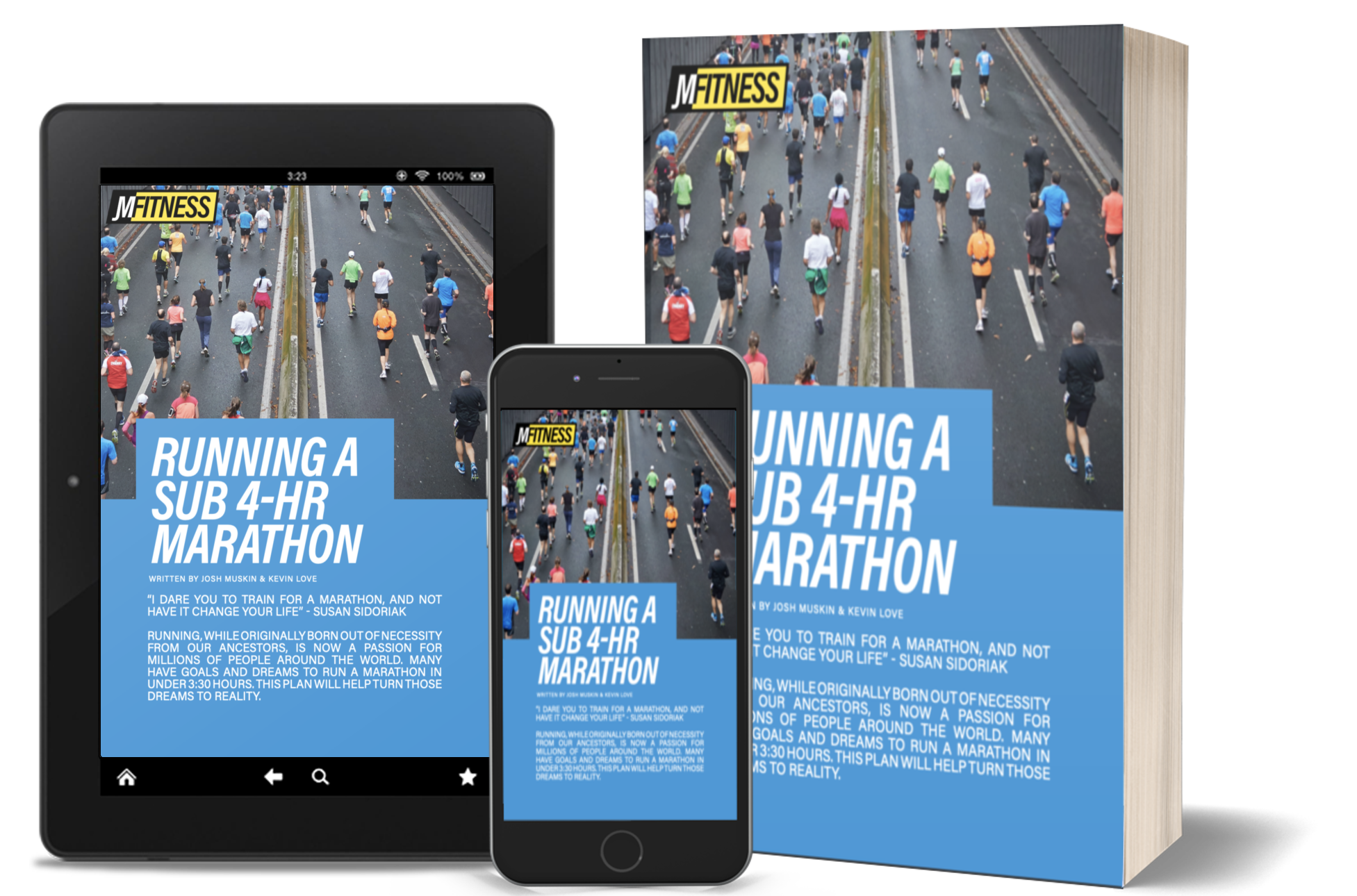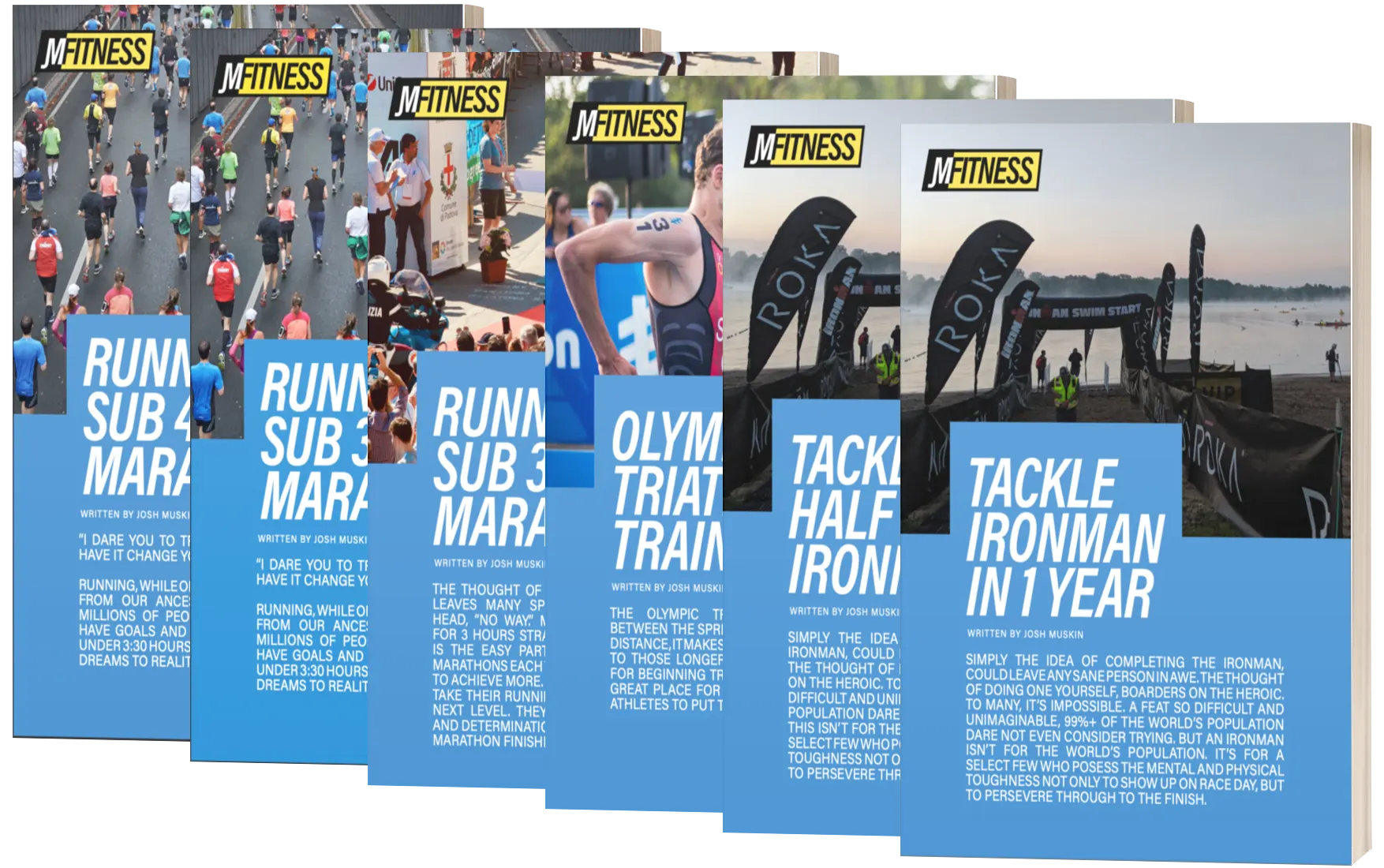Millions of people strive to have a marathon finish time that starts with the number 3 – and this sub 4 hour marathon training plan is just the thing to get you there.
A mistake often made by runners looking to break the 4 hour barrier is the assumption that more/faster is simply better – and that’s just not the case.
There’s a lot more that goes into running a sub 4 hour marathon than just pounding pavement.
There are different types fo runs, diet considerations, and injury prevention measures to take into account.
Lucky for you, all of that is packaged up below – let’s dive in.
Note: looking for a different time goal? Check out all of the marathon training plans available and find the one best suited for you.
Let’s be clear – this sub 4 hour marathon training plan is not of the “couch to marathon” variety. You’ll need to have some sort of running foundation before starting the base phase.
This training plan is also 18 weeks long, so it’s important to be able to run 15-25 miles per week out of the gate.
Is it going to be Ok to move days around? Simply put, its OK!, Life happens and you will have to adjust – That being said its import to follow a few guide lines when adjusting workouts.
This is some body text.
Any marathon training plan is worthless if you’re injured.
That’s why this plan takes injury prevention seriously & follows something called the wave method.
The wave method essentially means that your difficulty and distance in training will increase for 2-3 consecutive weeks, followed by a decrease (i.e. easy) week.
This is done purposefully so your body can increase it’s level of running/aerobic fitness, while also being allowed to recover since you’ll constantly be pushing past your existing thresholds.
Other than remaining injury free – the point is to get you to the start line as fresh/healthy as possible with your body prepared to take on a 26.2 mile journey.
Adjusting to long distances and running for 2-3 hours in a stretch can be a big adjustment for many runners. For some this can be stressful and a big change. As your progress through the plan and the runs become longer, you will notice that walking is specifically brought up as an option. Part way through longer runs these are great opportunities to catch you breath quick, stretch out a tight muscle and even refill a water bottle.
Taking some time mid run to stop and walk for a minute, will over the long term help!
Your sub 4 hour marathon training plan is measured in weeks, and each week follows a similar pattern:
There are a few goals with this schedule:
If life gets in the way and you have to skip a day or move things around, do your best to keep the Sat/Sun runs together and rest immediately following. The other days of the week can be flip flopped if needed, it’s the long Sunday run that’s the most important.
You’re going to be running a lot, burning a lot of calories, and because of that – you’re going to have to eat.
A lot. Maybe more than you think.
That doesn’t mean “eat anything in sight” though – there are too many runners who sacrifice performance because they say things like “well I ran today I can eat whatever I want!”.
While, sure, you could, if you’re shooting for a time goal like sub 4 hours, it’s important to think about food as fuel.
So what should you eat? (disclaimer: everyone is different modify this to fit your body these are just general guidelines)
The easiest way to say it is – real food.
Meats & vegetables, nuts & seeds, some fruit, little starch, as little sugar as possible.
Stick to the outside of the grocery store with the exception of spices & oil.
You’ll be looking to avoid as much processed food as possible because it can actually slow you down (despite some of it tasting really, really good).
Real, whole foods not only do a better job of fueling the body – they can also aid in joint health and keep you injury free longer than eating predominantly processed foods.
In terms of how much food to eat – well that’s unique to you – but there are tools that can help you figure it out.
Using something like MyFitnessPal can help you track calories & macros (fat/protein/carb) intake – and if you have a Garmin device, you can sync the two to see calories in vs calories burned as well.
Keep a food journal (on paper or in the app) for about a week, marking what you ate and how your workouts felt.
Play with the ratios, types of food, times you eat, until you’re consistently feeling more energy and better in your workouts – then hang out in that range for the duration of your training.
Remember, during this training plan, your food isn’t food, it’s fuel.
Make sure you’re taking in enough of the real stuff to give you the energy and stamina you need to train.
After all, if you don’t train well, chances are you won’t race well.
With diet, format, run types and all that out of the way, let’s talk about the various different phases that you’ll encounter in this sub 4 hour marathon training plan:
Building an endurance baseline
Steadily increase training volume & distance
Safely hit maximum mileage ahead of race day
Rest and recover the body while maintaining fitness for race day
Each phase will follow the weekly schedule outlined above, but the intensity, and length of the workouts will vary.
The base phase of the plan isn’t flashy or terribly ‘cool’ but it’s vital to your success in breaking the 4 hour mark.
This phase is built up of consistent distance/pace runs over a number of weeks to make sure your fitness is at a baseline level that will allow for more volume to be placed on top.
Getting really comfortable at short/medium distances makes attacking longer and more intense runs more manageable because you’re viewing them as runs that are just ‘a little longer’ than you’re used to, vs trying to jump into a 10 mile tempo run too early and risk injury.
Build phase is where a good portion of your work begins.
Here, you’ll be asked to increase the length, distance, duration and intensity of your runs (both workouts, recovery runs, and the long runs).
The increases here will still be pretty gradual, 10-15% per week) following the wave method to help avoid injury.
The last week in the wave, before the rest week, will challenge you and push you. Here you’ll finally be exploring what it’s like to push past your existing thresholds as you build new layers of fitness, and start to (probably) make some new PR/PBs on shorter distance runs done at higher intensity.
This is where the training plan gets real.
Your Sunday long runs are the runs impacted the most in peak phase, and they come at you fast.
Increasing all the way up to the 20 mile mark (sometimes more than once) this is where you really start to experience what it’s like to run for long periods of time near your race pace.
This phase is the hardest on the body because of the sheer amount of miles that need to be put in, so it’s important to remember a few things:
Peak phase is challenging, but it’s also rewarding to watch yourself achieve speed/distance like you likely haven’t ever before. Besides, after peak is over, you get to enjoy…
This phase is harder than it sounds.
That seems silly to say considering this phase is a literal decrease in mileage leading up to race day – but mentally it can be challenging.
You’ve just spent weeks going hard, going long, and pushing into new territory – so suddenly doing the exact opposite of that feels, well it feels wrong.
But it’s important.
All of your hard work is done, it was done in build and peak phases – so the fitness you’ve built is there.
Now is the time to protect and preserve it.
Slowing the body down, easing the burden on your legs, allows you to get to the start line fresh & ready to go – which is the only way you’re going to accomplish your sub 4 hour goal.
So despite how difficult it can feel to ‘go easy for a while’ do it – set yourself up for success, and on race day – attack.
This 28 page ebook (PDF) includes nutrition guidance, injury prevention tips, a detailed breakdown of how to break 4 hours, & more!
See What's Inside
Check out our library of triathlon and running training plans. From a half marathon to a full Ironman® triathlon, we have you covered.
Choose plan


”


Get exclusive training secrets and productivity tips in your inbox to level up your life.